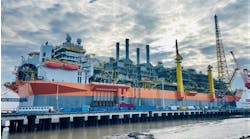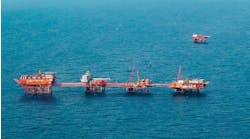Offshore staff
With the UK government looking toward fast-track production, the NSTA has identified four priority cluster areas in the southern North Sea, all close to infrastructure, and will seek to award licenses in these areas ahead of others.
According to the NSTA's analysis, the average time between discovery and first production in UK waters is close to five years.
Earlier this year the NSTA asked leading operators in the sector for details of their production and investment plans and to investigate how they might advance these programs.
Other measures include licensing the Rough gas storage facility in the UK southern North Sea and encouraging operators to look at reopening closed wells.
Oil and gas currently contribute around three quarters of the UK’s domestic energy needs will continue to play an important role going forward into the energy transition.
Acreage will also be offered west of Shetland in the northern and central North Sea and the East Irish Sea.
Applications for the 33rd round are open until Jan. 12, 2023. The first license awards should follow in second-quarter 2023.
The NSTA intends to award blocks in tranches with those that have the potential to produce quickly taking precedence, pending further environmental assessments in certain cases.
The blocks offered have been agreed following consultation with other relevant public bodies regarding other activities and plans for the area.
NSTA CEO Dr. Andy Samuel said, “Security of supply and net zero should not be in conflict. The industry has committed to halving upstream emissions by 2030 and investing heavily in electrification, carbon storage and hydrogen.
“Signs are promising so far—our first carbon storage round closed last month with 26 applications from 19 companies across all the areas we offered.”
The UK oil and gas licensing round will help sustain the offshore industry and strengthen the UK’s plans for a low-carbon future, said industry association Offshore Energies UK (OEUK).
Greenhouse-gas emissions generated in producing oil and gas from newer fields will be far smaller than in older ones, OEUK added, with new installations designed from the outset to minimize leakage of gas and avoid routine flaring or venting.
The Climate Change Committee’s "Balanced Pathway" estimates that the UK will consume gas and oil equivalent to 8 Bbbl of oil by 2030. OEUK’s research suggests the UK North Sea could produce only about half this amount even if all planned developments went ahead, so the rest would be imported.
UK licensing rounds used to be annual events, but the previous (32nd) licensing round was launched in July 2019 and released in Sept 2020 with 113 licenses awarded to 65 companies. The process had been on hold since then, pending consultations on the environmental impacts of further oil and gas exploration.
That delay, plus other factors such as the pandemic, meant that just five UK offshore exploration wells were drilled in 2021—the lowest number ever—according to OEUK’s Economic Report 2022.
Mike Tholen, OEUK’s acting CEO, said, “Many existing UK oil and gas fields are in decline so the risk is that production will drop much faster than demand, leaving us more dependent on imports. That is why new licenses are so important.
“New licenses also help maintain continuity for the energy operators and for our vital supply chain companies which, between them, employ over 200,000 people.The success of this and the next licensing rounds will be vital for our nation’s long-term energy security and to ensure we deliver on the UK’s commitment to reach net zero by 2050.”
Analysis
Since the last UK round in 2019, UK and European energy security has been thrown into the spotlight and a climate compatibility checkpoint has been introduced to ensure any round is consistent with net-zero goals, according to a recent Wood Mackenzie’s analysis.There have been discoveries in recent years, but not since the 27th round in 2012 has new acreage delivered a commercial discovery. And the first well from the last round (2019) is not expected until 2023.
The discovered resource opportunities could have a bigger impact, the report stated. WoodMac analysts estimate nearly 2 Bboe will be up for grabs, over a third of which is gas.
The licensing round highlights four priority cluster areas in the Southern North Sea (Greater Pegasus Area, Greater West Sole Area, Greater Cygnus Area and Cotton Area). These clusters include 30 predominantly gas discoveries that could be developed quickly and make use of nearby infrastructure. In total, they could deliver 1 Tcf of new supply, enough to meet 40% of the UK’s yearly gas demand.
While these discoveries will have been previously relinquished, WoodMac says current commodity prices and area-wide solutions could unlock on their potential.
10.07.2022





